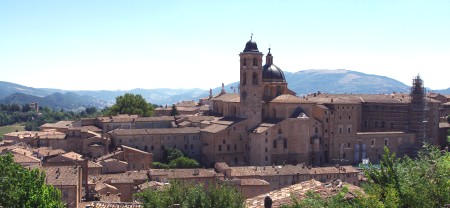
|
| |

The Ducal Palace
|
Urbino Obelisk
| Present Site: | Via Aurelio Saffi, Urbino (Side of Ducale Palace (Palazzo Ducale)) N 43°43'27.4"(43.724268) E 12°38'12.9"(12.636922) |
| Pharaoh: | Pharaoh Wahibre (Apries in Ancient Greek) (Third Intermediate Period of Egypt, 26th Dynasty, Reigned 6th Century BC) |
| Measurement: | Unknown |
| Stone: | Red granite |
About The Site:
Urbino is a town which was registered as UNESCO World Heritage in 1998, remains medieval streets of the Renaissance. Ducale Palace (Palazzo Ducale) which is the center of the town, was completed in 1536, is currently used as Galleria Nazionale delle Marche. Urbino is also known as the town where Raphael was born. Raphael was born in 1483 and has been spent in this town until boyhood. The birthplace of Raphael is in existence, is open publicly as a small museum. The statue of Raphael is on the north side of the old town. (See picture)
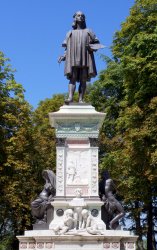 The Statue of Raphael
The Statue of Raphael
|
Many books and websites often say that the obelisk site is in Piazza del Rinascimento (Renaissance in Italy). However the Piazza is slightly north of the location where the obelisk stands, a small square in front of Chiesa di San Domenico. The place where the obelisk stands is a center of the street, not in the square. The name of street is Via Aurelio Saffi.
How To Get There:
Urbino is about 200km north of Rome, is a small town among the mountains, but came to be known widely since it was registered as UNESCO World Heritage.
No railway is available, general directions is going by rail to Pesaro of the Adriatic coast, and then direct to Urbino by bus from Pesaro. However, the direct train for Pesaro from Rome is only once a day. The other must once transfer at Ancona or other stations, which takes more than four hours. The bus between Pesaro and Urbino leaves 1 or 2 times an hour, and the travel time is about 45 to 65 minutes.
The more convenient and quicker way would be using a direct long-distance bus for Urbino from Rome, which leaves twice a day for weekdays and once a day on Sunday.
The terminal for this long-distance bus is located near to the Roma Tiburtina Station of Metro Line A and FS (Ferrovie dello Stato). The bus is co-operated by Adriabus and Bucci Bus, departs at 06:30 and 16:00 for Urbino (only 17:00 for Sunday), as of August 2016. (When I visited in August 2013, website said for Rimini, but for Urbino in fact, and only one service a day at 07:30.) Travel time from Rome to Urbino is 4 hours 15 minutes, and the bus arrives at the bus terminal at the north square of Palazzo Ducale.
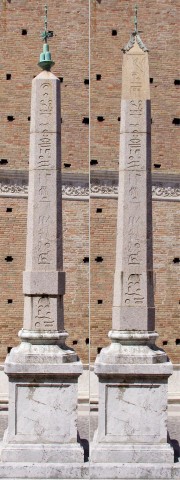 Restoration Image of Urbino Obelisk (right)
Restoration Image of Urbino Obelisk (right)
|
There is no way to climb up directly from the bus terminal to the Palazzo Ducale on top of the hill. Although it's considerably to detour, enter into the town from the gate of the north side of the bus terminal.
The obelisk stands on Via Aurelio Saffi which is east of Palazzo Ducale, is located approximately in the center of the old town of Urbino. We will never get lost if we have a map since the old town is so small.
About The Obelisk:
This obelisk is one of pair of Minerva Obelisk, which were originally erected as a pair at Sais, a town in Nile Delta region by Pharaoh Wahibre (well-known as Apries in Greek name) of Third Intermediate Period of Egypt, 26th Dynasty, in around 580 BC.
This obelisk was transported from Sais to Rome in late 1st century, and it was erected for Iseum (The temple of Isis). Then it toppled and broken in three pieces. In 1676, it was discovered by Bellori at the underground near of Piazza della Minerva (the site where The temple of Isis had once been here), and acquired by Cardinal Alessandro Albani. He preserved it in his "Villa Albani". When he became the Pope Pope Clement XI in 1700, he wanted to donated it to the town of Urbino which is his home town. Then the obelisk was transported to this town in 1737.
The remarkable characteristic of this obelisk is an octagon shape, with cutting off the four corners. Probably it was heavily damaged when it was discovered, and repair was given up. The inscriptions on south and east sides remain, but while the inscription of Minerva Obelisk is in accordance with the proper style, this inscription is unnatural feel like the part remains. On the north and west sides, the inscriptions can not be read as remain only like lines, since it has heavily worn.
We can understand both obelisks (Urbino and Minerva) are pair, because we see the similar inscriptions of east side of both obelisks. In the meantime, we notice some points below.
Firstly, the inscriptions of Minerva Obelisk, all the four sides, begin with the horus name. However, we cannot find the horus name at Urbino Obelisk. It is hardly believe that the configuration of both inscriptions of pair obelisk are different. Perhaps the upper part of Urbino Obelisk was later processed with pyramid-shaped Pyramidion since the part of horus name was missing.
Secondly, the Urbino Obelisk has an unique shape, the obelisk of the body is divided at the lower portion, and the square stone is girdled like a "belt" (See picture). It's clearly understand that the stone is the same material of red granite, If so, I assume this square stone was either originally at the middle of fragmented obelisk, or originally at the pedestal and inserted it between upper and bottom portions when it was repaired.
The picture left side shows my image of the original obelisk of Urbino, based on my assumption above. The "belt" material was brought to the bottom, and the horus name portion was supplemented.
Notes For Pictures:
The conservation condition is poor, and the inscriptions except east side are almost impossible to read. Also, the upper portion is missing. We may be disappointed if we visit only this obelisk. So, we should see other places as there are many interested points along the the Adriatic coast.
 South Side |
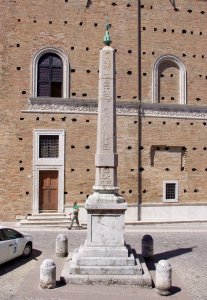 East Side |
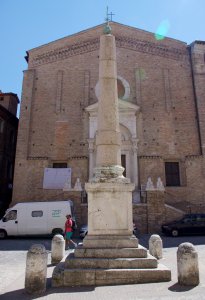 West Side |
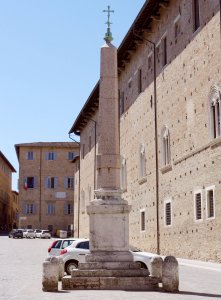 North Side |
|||
August 12, 2013 by Hiroyuki Nagase (For high definition image, please click the picture) | ||||||
Copyright Hiroyuki Nagase nagase@obelisks.org and Shoji Okamoto okamoto@obelisks.org